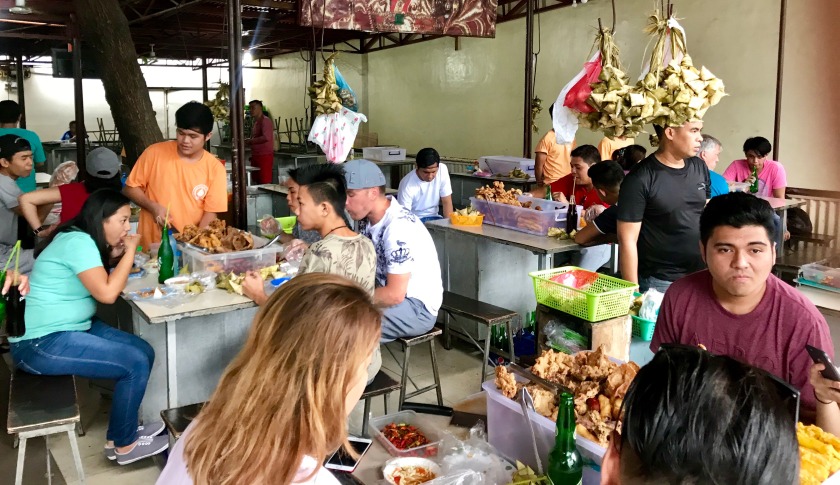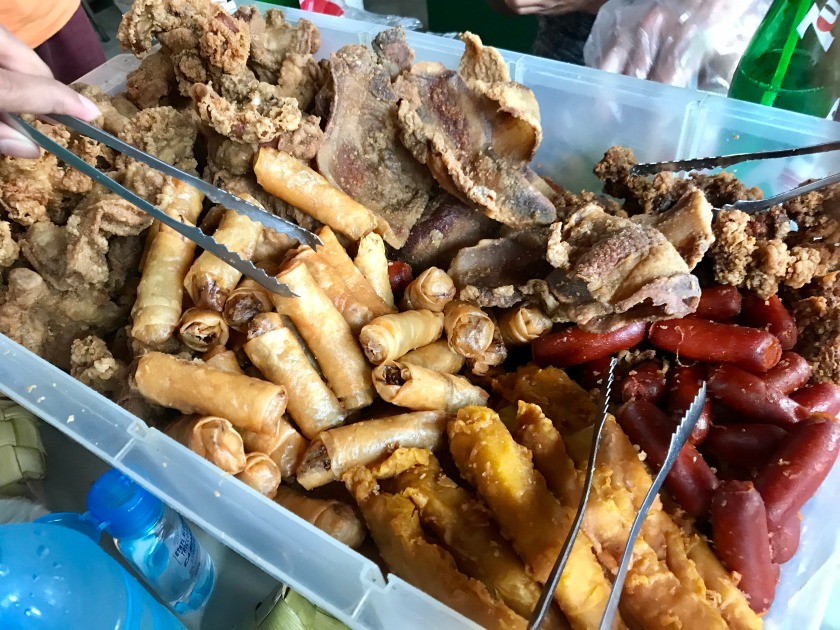One will never be regarded as truly Cebuana if she hasn’t experienced Cebu’s famous gastronomic food – Pungko Pungko. Pungko is a Visayan term which means to crouch or squat. I remember few years back, Pungko-Pungko vendors used to peddle basketful fried viands from one place to another. Then, at a corner or street where they see customers, they will do a momentary stop and start vending. My brother, James must be a fan of this stuff since he was the one who introduced this to me at a young age. Thereupon, when we’re in the downtown area of Cebu, we would try to snag Pungko Pungko vendors near Cebu Doctor’s Hospital in the hope to satisfy our cravings. That time, wooden stools weren’t promptly available, so we would just squat or crouch in the pavement after we don a transparent plastic in our hands and seize food from the makeshift table.
Today, Pungko-Pungko has evolved gregariously. Patrons no longer eat in crouching position but are comfortably settling in wooden pews. Pungko-Pungko stalls have also sprang everywhere. You usually find them in places near schools/universities, churches, or in places with high populace.

One of the most popular and accessible Pungko-Pungko places in Cebu is located in Fuente Osmena. There are about 20+ stalls in this stretch. Vendors lease a stall for a monthly low-fixed-rent and their spot is constantly reeled to have a fair share of revenue (since strategic location greatly impacts their sales level). Today, they may occupy the front most stall and tomorrow at the rearmost. Operating hours starts at 6am and ends at 9pm.
The way to enjoy Pungko-Pungko is to eat with pride. Although this may not be advisable for people with sensitive stomach, Pungko-Pungko remains the go-to place for frugal Cebuanas. With a fifty-peso budget, you can already relish a great meal. The basket is normally filled with these enslaving fried nom noms:
- Ngohiong (Chinese Spring Rolls)- Php 10.00
- Longganisa (Sausage) – Php 12.00
- Pinakupsan (a fatty part of pork deeply fried using its own oil until it shrinks) – Php 15.00
- Utok (swine’s brain) – Php 15.00
- Ginabot (intestine) – Php 15.00
- Lumpia Tague (spring roll bean sprouts) – Php 5.00
- Crab meat – Php 20.00
- Pasayan (Shrimps) – Php 20.00
- Porkchop -Php 45.00
-

-
A basketful addictive nom nom.
It is best to pair them with puso (hanging rice) which only cost Php 4.00.

Then soak them in vinegar-filled bowl packed with white onions and peppers, given for free by Kuya.

You can either choose water or soft drinks (normal offerings are pepsi products) as your refreshments.

I’m glad this kind of gastronomy is gaining popularity. I hope you get to try this too. Certified nom nom from head to toe!

Remembering my MSY times… I used to ate Pungko2 on my way home after a tiring Office Work..
LikeLiked by 1 person
When are you back in Cebu? Let’s eat here again. I will make a sequel of this article.
LikeLike
Ian, thanks for making a blog about pungko2…. Now ,lets bring the famous pungko2 in cebu to Danao. I am starting with the preparation now. Already have tables and chairs, rolling store, already ordered the hanging rice and most of all i do have hundred kilos of intestine and meat … Lumpia taugi? No problem…..
LikeLiked by 1 person
Thanks James! We are looking forward having you in Danao. Let me know where will you be locating so I can write something about you and your new business venture. Good luck!
LikeLike
Great job, Ian. 🙂
LikeLiked by 1 person
Thank you ♥️
LikeLike